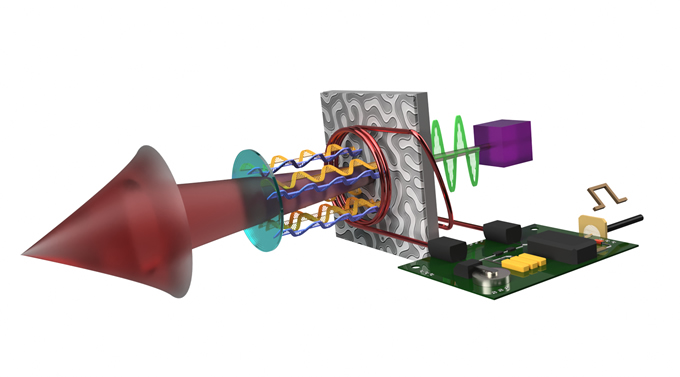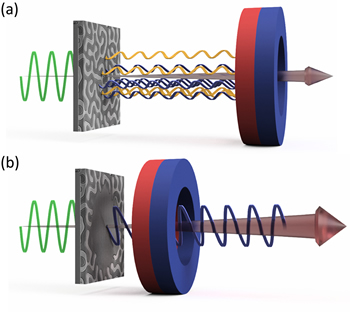
ここからコンテンツです。

World First Demo of Labyrinth Magnetic-Domain-Optical Q-switched Laser
A submillimeter-thick film with magnetic microdomains was used to control a Q-switched laser, increasing its pulse power 1,000 times By Taichi Goto
Taichi Goto and his colleagues have fabricated the first magneto-optical (MO) Q-switched laser. Unlike electro-optic (EO) and acousto-optic (AO) effects, MO effects had not previously been used in Q-switched lasers, although the effects themselves are very well-known. The fabricated MO Q-switched laser contributes to the development of compact high-power lasers.
The “Industry 4.0” concept, first introduced by the German government, has recently extended the scope of compact high-power laser applications to, for instance, laser manufacturing, vehicle engine development, or thruster systems for space exploration.
However, integration of a controllable Q-switch into compact solid-state lasers has been challenging because of the mechanisms of EO and AO effects. In addition, previous Q-switches needed a large-sized power supply, which prevented downscaling of the entire system.

Now, Taichi Goto, in cooperation with researchers at Iowa State University, and the Institute for Molecular Science have developed a magneto-optic (MO) Q-switched laser for the first time, using a 190-micron-thick magnetic garnet film with labyrinth-shaped magnetic domains. They used custom-made coil and circuits to generate the pulsed magnetic field to be applied to the magnetic garnet, and successfully generated optical output with a pulse width in the tens of nanoseconds range. This was the first ever demonstration of a Q-switched laser driven by magnetic domain motions, and also the first evidence of the possibility of an integrated Q-switched laser. “The device was two orders of magnitude smaller than other reported controllable Q-switches,” commented Associate Professor Taira.

“The most difficult part of realizing MO Q-switching was to combine three different techniques/fields: the preparation of a magnetic material, the fabrication of a high-speed magnetic field switch, and the construction of a laser cavity,” explained PhD candidate Ryohei Morimoto.
According to Assistant Professor Taichi Goto, “there are no previous reports of MO Q-switches using thin garnets. This is not only the first demonstration, but it also represents an important first step in the development of an integrated high-power laser.”
“We enjoy our collaboration and learn from each other,” said Professor Mina Mani. “We further hope not only to advance research and create and pursue new challenges, but also to use science and technology to make a better world for us all.” In addition, the researchers found a unique biasing technique that uses magnetism to decrease the electric power needed for Q-switching. When a ring-shaped permanent magnet was placed close to the magnetic garnet, they were able to generate the same optical pulse in the MO Q-switched laser using seven times less electric power. This result showed that this Q-switch does not need a large power supply for operation, meaning that drastic downscaling can be expected. The research team would like their future studies to be useful for laser users all around the world and to help in the establishment of new industries.
We acknowledge support from the following institutions:
- Japan Society for the Promotion of Science (JSPS) KAKENHI Nos. 26706009, 26600043, 26220902, 25820124, and 15H02240.
- Japan Science and Technology Agency (JST) – Promoting individual research to nurture the seeds of future innovation and organizing unique, innovative network (PRESTO).
Reference
T. Goto, R. Morimoto, J. W. Pritchard, M. Mina, H. Takagi, Y. Nakamura, P. B. Lim, T. Taira, and M. Inoue, (2016)."Magneto-optical Q-switching using magnetic garnet film with micromagnetic domains," Opt. Express, 24, (16), 17635-17643. DOI: 10.1364/OE.24.017635.
世界初の迷路磁区を使った磁気光学Qスイッチレーザー
新原理に基づいた国産Qスイッチレーザーの発想から実証まで豊橋術科学大学,アイオワ州立大学,分子科学研究所の研究者らは,共同で磁場と光の相互作用である磁気光学効果を発現する膜を用いた,集積化可能なQスイッチレーザーの開発を世界で初めて成功させました。本成果は小型高出力レーザーの発展に寄与するものです。
高出力、高繰り返し、高安定な小型レーザーは、日々の製造プロセスを、よりシンプルで、低コスト、スピーディーなものに変えうると期待されています。ドイツでは、製造現場のデジタル化(高度情報化)がもたらす製造業の変革をインダストリー4.0と名付けられ、全工程の制御自動化が一つのキーポイントとなってきており、レーザー加工はこれに大きく寄与し得ます。小型高出力レーザーの適用先は、これにとどまらず、自動車エンジンの点火プラグや、宇宙開発用スラスターシステムでの利用など多岐に渡ります。
しかし、これまで、レーザーが出るタイミングや、繰り返し回数などが、制御可能で集積化可能な固体レーザー向けのQスイッチ素子は無く、開発が切望されていました。制御可能なQスイッチ素子は、電気光学素子や音響光学素子が広く知られていましたが、光学素子の付属が必要であったり、分厚い結晶を用いる必要があったりと、原理的にmm以下の小型化が不可能でした。更にどちらも複雑かつ大型の制御電源が必須であり、小型レーザー本体のコンセプトにそぐわないものでした。
豊橋術科学大学電気・電子情報工学系の後藤太一助教、分子科学研究所、アイオワ州立大学の研究者らのグループは、迷路状の磁気ドメインをもつ厚さ190マイクロメートル(マイクロは10万分の1)の透明磁性材料を用いて、初めて、膜のQスイッチの開発に成功しました。磁気ドメインとは、磁石のN極とS極が膜の面の中に、ランダムに点在することによって生じるもので、磁気のまだら模様と言い表すことができます。実験では、高速磁気パルスを、透明磁石材料に印加し、パルス幅45ナノ秒(ナノは1億分の1)、ピーク値約20ワットの、Qスイッチレーザーの取得に成功しました。これは、集積化可能な磁石材料を使った世界で初めてのQスイッチレーザーの結果報告となります。
さらに、磁性体の強みを活かし、小型永久磁石を、透明磁石材料の近くに設置することで、レーザーパルス発生に必要な電流を、7分の1にまで、低減できることを実験によって示し、チップに収まる程度の小型の制御回路で、同機能が実現できることも示しました。本成果は小型高出力レーザーの発展に大きく寄与することが期待されます。
本研究は以下の助成を受けて行われました。
- 日本学術振興会 科研費 26706009, 26600043, 26220902, 25820124, 15H02240
- 国立研究開発法人 科学技術振興機構 さきがけ
Researcher Profile

| Name | Taichi Goto |
|---|---|
| Affiliation | Department of Electrical and Electronic Information Engineering |
| Title | Assistant Professor |
| Fields of Research | Magnetics / Optics/ Photonics/ Nanotechnology |
ここでコンテンツ終わりです。
